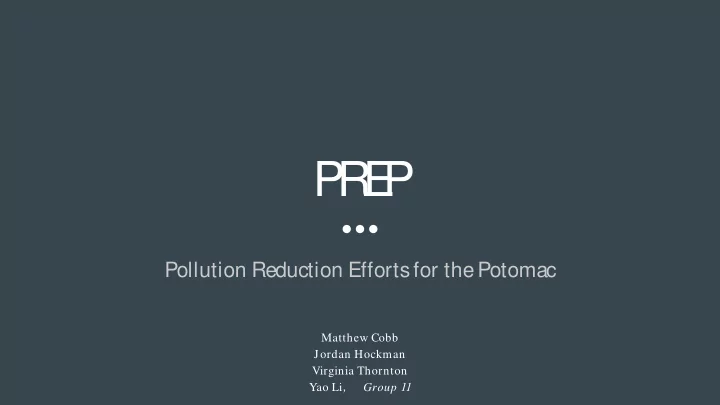

P R E P Pollution Reduction Efforts for the Potomac Matthew Cobb Jordan Hockman Virginia Thornton Yao Li , Group 11
P resentation O verview 1 . Team’s Mission Statement and Objective 2. Watershed Characteristics 3. Watershed History and Governance 4. Major Pollution Issues 5. PREP’s Goal and Strategy a. Sewage b. Agriculture c. Stormwater 6. Conclusion and Recommendations
P R E P -Pollution Reduction E fforts for the Potomac Mission S Statement: Reduce upstream pollution loads to the Washington Region of the Potomac River by the year 2030. PR PREP P Objectives: Concentrating on sewage discharge, agricultural inputs, and stormwater piping issues: Introduce holistic land management practices Require water quality standards for all influents
P otomac R iver -W atershed Characteristics
W ashington R egion of P otomac -W ater Quality D ata
History and G overnance Before 1800s 1894 to 1975 1976 to now
● 4 States ● Capital ● 7 cities > 40 square miles
History and G overnance ● 1 81 0, first sewer system in Washington ● 1894, un unfit for bathing, dr drinking, a and c d cooking (US Pub ublic H Health) h) ● 1 940, Interstate Commission on the Potomac River Basin ● 1976, largem emouth bass reap eappear eared ed and pleas asure e boats red ediscover ered ed ● 1 978, CO-OP Low Flow Allocation Agreement ● 1 982, CO-OP Water Supply Coordination Agreement
P otomac -Pollution Challenges 1 . Sewage Discharge a. Local wastewater treatment plants have been working to improve their discharge since the 60’s b. High levels of contaminants like ammonium and organic nitrogen have contributed to serious nutrient loading issues in the Potomac c. Lots of progress thus far, but continued progress is needed 2. Agriculture Inputs a. Fertilizers that are nutrient rich, nitrogen & phosphorus, enter local waterways b. Livestock manure also a factor for pollution c. Nutrients from fertilizers can also leach into groundwater sources, posing a drinking water concern 3. Stormwater Piping a. DC’s topography is predispositioned for flooding, especially around historic and government sites b. A combined sewer system limits the amount of discharge the system can handle c. Increased urbanization creates more runoff and less infiltration
P R E P -Sewage D ischarge Strategy Consider a Cap-and-Trade policy among all local discharge sources to ensure wastewater effluent contributions are minimal Increase the partnership of multiple levels of government to fund further ability to reduce concentrations of COC Explore better methods of river sampling to ensure reliability of water quality data
P R E P -A gricultural Input Strategy Propose methods for which farmers can minimize the application of fertilizers to fields Monitor fertilizer levels if possible to reduce application in areas where nutrients are in an acceptable range Increase management of livestock manure Plant more natural buffers around fields Especially fields that neighbor bodies of water Includes: Trees, Shrubs and Grasses Continue to educate the public to ensure awareness of the problems and those who are at stake
P R E P -Stormwater Piping Strategy Continue the National Capital Planning Commission’s Flood & Stormwater plans Increase scrutiny of development in floodplains Update FEMA maps every 5 years, include tidal flooding Develop emergency flood plans with ACOE and local governments Revise every 3 years, include 50 year storm events and smaller Explore community centered green stormwater infrastructure
C onclusions and R ecommendations Increased legislation and regulation for water quality in the Potomac is necessary for improved overall health Consistent monitoring and measurements are needed to ensure that water quality data is accurate and up to date New and/or improved methods are required to reduce contaminant loads from entering waterways Funding and increased awareness are essential for the restoration of the Potomac
R eferences History: http:/ / cdn.knightlab.com/ libs/ timeline3/ latest/ embed/ index.html?source=1pF_QXJn2hQ2MVU9iSyJVq-J1xkcGamZzEQUEcYVnm7o&font=Playfair&lang=en&height=650 General Info: http:/ / www.potomacriver.org/ potomac-basin-facts/ Washington Region Water Quality Info: http:/ / www.mwcog.org/ environment/ water/ downloads/ Potomac%20WQ%20factsheet_January%202014.pdf Nutrient Loading in Potomac River Basin http:/ / pubs.usgs.gov/ circ/ circ1166/ circ1166.pdf History and Pollution Issues http:/ / www.thehoya.com/ pollution-persists-potomac-river/ Potomac Flow Analysis http:/ / citeseerx.ist.psu.edu/ viewdoc/ download?doi=10.1.1.364.8025&rep=rep1&type=pdf Interstate Commision on the Potomac River Basin : http:/ / www.potomacriver.org/ Agricultural Pollution http:/ / earthjustice.org/ our_work/ cases/ 2013/ defending-the-clean-water-act-against-agricultural-pollution Nutrient Pollution https:/ / www.epa.gov/ nutrientpollution
P R E P Pollution Reduction Efforts for the Potomac
Recommend
More recommend